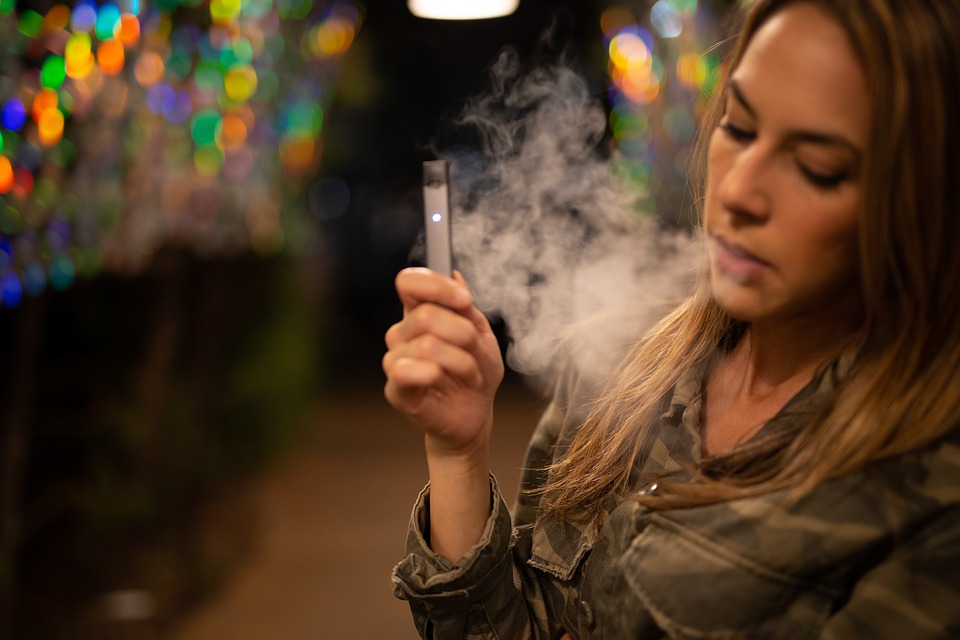Parent’s Guide To Vaping | Everything They Won’t Tell You
It seems like vaping has been breaking news every day for the last few weeks. So much so that I’m sure you are well aware of the “teen vaping epidemic” that is sweeping the nation. Every news outlet has been reporting about the 450+ people that have gotten sick due to some “mystery vape illness” and the 6 people that have died because of vaping. But are they telling us the whole story?
Call me a skeptic but the media is in the business of breaking news. They might sensationalize headlines to get more clicks. And, they probably won’t do extensive research since they have to rush their articles out before the next news outlet does. And, most tend to be biassed towards their agendas.
Luckily, I’m not a news outlet. I’m a parent that can dig a little bit deeper to find out everything they won’t tell us. And, that’s exactly what I did to present you with this parent’s guide to vaping.

What Is Vaping?
Vaping is the act of inhaling and exhaling vapor which is produced by an e-cigarette or similar device.1 It is called vaping because it does not produce any smoke. The vapor looks very similar to smoke. But, vaping doesn’t produce smoke since there is no combustion of tobacco during the vaping process.
The vapor that is produced is an aerosol that usually contains propylene glycol, glycerin, flavorings, and nicotine.2 It is important to note that nicotine is optional.
Notice that I said usually? This is a key since there is a recent trend of people vaping things other than nicotine. Vaping CBD or THC (in some states) is becoming very popular with their recent legalizations.
What Exactly Is A Vape?
Vapes come in many different shapes and sizes. They can be an all in one device the size of a USB stick. They can also replicate the look of conventional cigarettes, cigars, or pipes. Some of them can be as simple as a metal tube with a battery inside and a heating element on top. While another option would be a regulated mod with a tank. There are too many variations to say with any specificity what exactly a vape looks like.
But, every single vaping device has a few things in common. They are all battery-powered. The electrical power from the battery is used to power a heating element. The heating element is fed a liquid by various means. Heating the liquid creates an aerosol. The aerosol is then inhaled through a mouthpiece.
If a device is designed to do what I just stated, the FDA considers the device to be an Electronic Nicotine Delivery System (ENDS for short). And, ENDS are subject to their regulation.3
What Goes Inside A Vape?
People who use vaping as a smoking cessation tool use an e-liquid inside their vape. The e-liquid consists of 3 main ingredients: propylene glycol, vegetable glycerin, and nicotine. Then, flavorings are added to this mixture.
There are thousands of e-liquid manufacturers across the United States. Each of them produces anywhere from a few to a few hundred different flavored e-liquids. All of them start with the 3 main ingredients: propylene glycol, vegetable glycerin, and nicotine. The only thing that sets them apart from each other is the flavorings.
Is Vaping The Same As Smoking?
Vaping is not the same as smoking. When someone smokes tobacco, they have to set the tobacco on fire. The process of combustion is a chemical reaction that’s capable of changing matter.4 This means that when a cigarette burns, the chemicals in the tobacco are changed into new chemicals. Many of which are toxic.
There is no combustion taking place with vaping.
Is Vaping Safe?
Vaping is not safe. There have not been any long term studies done on the effects that vaping has on people. US food authorities have declared propylene glycol & vegetable glycerin as generally safe for use in foods. But, there haven’t been any long term studies on their effects when inhaled. Also, we know that nicotine is a highly addictive drug. While not cancer-causing or excessively harmful on its own, it exposes people to the extremely harmful effects of tobacco dependence.7
Plus, the last ingredient of e-liquid is flavoring. And, flavoring introduces a whole list of chemicals by themselves. Since the flavoring varies widely between different manufacturers and flavors, there is no way to say with certainty exactly what chemicals are in any given vape.

Is Vaping More Safer Than Smoking?
Regular tobacco cigarette smoke contains more than 7,000 chemicals. Of the 7,000 chemicals, at least 250 are known to be harmful (hydrogen cyanide, carbon monoxide, and ammonia). And, among the 250 harmful chemicals, there are at least 69 chemicals that are known to cause cancer (acetaldehyde, arsenic, and benzene).8
While we don’t know exactly what chemicals are in e-cigarettes, Dr. Michael Joseph Blaha of John Hopkins said: “there’s almost no doubt that they expose you to fewer toxic chemicals than traditional cigarettes.”9
The British Royal College of Physicians even released a statement that said: “Although it is not possible to estimate the long-term health risks associated with e-cigarettes precisely, the available data suggest that they are unlikely to exceed 5% of those associated with smoked tobacco products, and may well be substantially lower than this figure.”10
The highly regarded British Royal College of Physicians says that vaping is more than 95% safer than smoking traditional tobacco cigarettes. To take it a step further, Hospitals in the U.K. have even allowed vape shops to open inside the hospitals in a bid to help people stop smoking and start vaping.11
What About The 450+ Sick People And The 6 That Have Died Due To Vaping?
Vaping nicotine has its risks. But, the 450+ sick people and the 6 that have died is a new issue. Unfortunately, everything is getting lumped together. This is leading to a lot of people being misinformed.
The New York State Department of Health released a statement that said: “Laboratory test results showed very high levels of vitamin E acetate in nearly all cannabis-containing samples analyzed by the Wadsworth Center as part of this investigation. At least one vitamin E acetate containing vape product has been linked to each patient who submitted a product for testing. Vitamin E acetate is not an approved additive for New York State Medical Marijuana Program-authorized vape products and was not seen in the nicotine-based products that were tested.”12
So, a majority (if not all of these cases) are due to high levels of vitamin E acetate. Vitamin E acetate is not found it nicotine-based products. Vitamin E acetate is used as an oil cutting agent used in the production of THC cartridges. THC (tetrahydrocannabinol) is the chemical responsible for most of marijuana’s psychological effects.13
Are Vapes Regulated By The FDA?
The FDA’s “deeming rule” went into effect on Aug. 8, 2016. This rule gave the FDA regulatory authority over all ENDS products. Initially, it set a federal minimum age of 18 to purchase vaping products, it placed a ban on free samples and required that any ENDS product introduced after Aug. 8 would have to apply for premarket approval. Products that we’re already on the market would have to submit a premarket approval (PMTA) by Aug. 8, 2018.14
In November of 2016, Scott Gottlieb took over as head of the FDA. On July 27, 2017, Gottlieb said that the FDA would extend the 2018 PMTA to Aug. 8, 2022. This would give the FDA time to create workable premarket review standards. Since then, the FDA has been working on finalizing its deeming rule.
On May 16, 2019, U.S. District Judge Paul W. Grimm of the U.S. District Court for the District of Maryland ruled that the FDA exceeded its legal authority by extending the PMTA date. He ordered that the FDA must require all ENDS products to submit a PMTA within 10 months (May 16, 2020).
So, the FDA regulates vapes. But, has the FDA done its job?
What Is The Legal Age To Vape?
The FDA’s deeming rule set the federal legal age to vape at 18. But, the states have the power to set their age requirements. And, many of them have.
Alabama, Alaska, Nebraska, and Utah have set their legal age to vape at 19.
Arkansas, California, Connecticut (takes effect Oct. 1), Delaware, Hawaii, Illinois, Maine, Maryland (Oct. 1), Massachusetts, New Jersey, New York (Nov. 13), Ohio (Oct. 17), Oregon, Texas, Utah (July 1, 2021), Vermont, Virginia, and Washington (Jan. 1, 2020) have set their legal age to vape at 21.15
Should Kids Vape?
Kids should not vape under any circumstances. First off, it’s illegal in every state and even at the federal level. But more importantly, vaping is not safe and nicotine is a highly addictive drug. Is there any reason you can think of for allowing kids access to a highly addictive drug?
The only reason anyone should vape is if they already smoke traditional tobacco and want a safer alternative to cigarettes.
 By Grace – Child Development Associate Teacher in California
By Grace – Child Development Associate Teacher in California
My husband Mark and I have been blessed with two beautiful, smart, positive (I can go on and on) girls… Kenzie & Kayla. And, we have learned many tips and tricks while raising them. Tips and tricks that we felt would be useful to other new parents out there. So, we started WAYISAVE as a website built by parents for parents to share the best baby deals, coupons, tips, tricks and the occasional piece of advice.
- centeronaddiction.org | what is vaping
- wikipedia.org | electronic cigarette
- fda.gov | vaporizers e-cigarettes and other electronic nicotine delivery systems
- canada.ca | tobacco behind the smoke
- healthline.com | propylene glycol
- healthline.com | vegetable glycerin
- medicalnewstoday.com | everything you need to know about nicotine
- cancer.gov | harms of cigarette smoking and health benefits of quitting
- hopkinsmedicine.org | 5 truths you need to know about vaping
- rcplondon.ac.uk | e-cigarettes inquiry
- nytimes.com | two uk hospitals allow vape shops in bid to promote smoking ban
- health.ny.gov | new york state department of health announces update on investigation into vaping-associated pulmonary illnesses
- livescience.com | what is thc
- fda.gov | how fda is regulating e-cigarettes
- vaping360.com | legal age to vape





